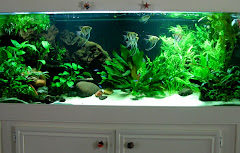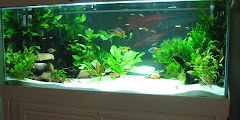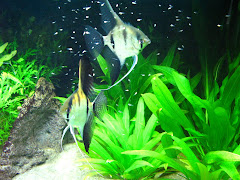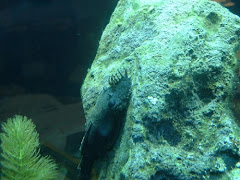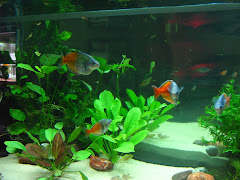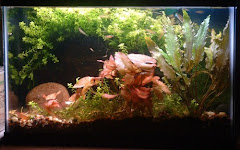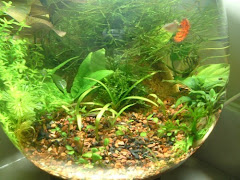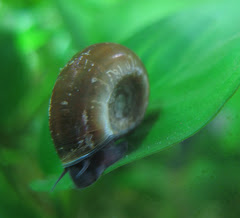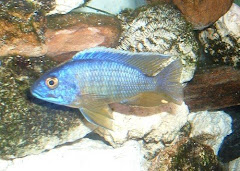After spending some time observing the goings-on in the 150, with the new additions of the festivus, I see that these charming little guys with the racing strips are rather tough customers, as I have been warned.
I note that since the addition of the single festivus a while back that I have not had the number of Endler's babies that I typically see in this tank. I have to net Endler's out of this tank from time to time, trading them and giving them away, and I have not had to do that since putting in the festivus, even though he's barely 2" long. OK, that's fine - I had too many Endler's in the past, and was disappointed that the wild caught angels did not reduce their number like I hoped. The festivus is up to the challenge.
Enter two new festivus. Feisty little fellows! They are lunging towards Endler's, they are lunging towards cardinals (someone on a forum commented recently that I might find myself without any tetras as the festivus matures) and they all seem quite interested in eliminating the snail population.
Hmmm. OK. I'm cool with this, actually. I won't cry if they wipe out the Endler's population -they are not appropriate for this tank anyway, and I can start a dedicated setup easily if need be - no problem. I have enough friends and relatives with my Endler's offspring that the group won't be lost forever. Better to not have a population explosion that is not being dealt with. I'm a bit torn about the cardinals, though. They get along famously with the wild angels - no sign that the angels have even the slightest piscivorous tendencies - and they look SO pretty. That will be a trick to get over, but I recognize that they might be eaten by the festivus as they reach mature size. The festivus have already shown strong tendencies towards hunting down small fish. I will have to switch to a larger, swifter tetra, and there are many species to choose from, so this won't be a big deal. I'll get over it! I still love the festivus, and want them to work out in this large tank.
Sunday, September 27, 2009
Festivum for the Rest of 'Em
Or, more correctly, "Festivus for the Rest of Us." Festivum is an old moniker that I have trouble giving up.
Yesterday I spotted some very fine-looking M. festivus types at the LFS. They had excellent color, good size, and were reportedly eating anything that went into the tank.
Several months ago I expressed an interest in getting more when talking to the people at the shop, since I took all they had (3) and subsequently was left with only one, but as time went by they did not get any more in, and I thought I might just stick with the one, since they are likely to get bigger than the leopoldi angels, and I did not want pairing up of that species in this tank.
Lo and behold, they got more in. The chap told me he ordered them "specially for you..." and I immediately felt guilty! I should not have - these fish move pretty well for them, and they were stocking them long before I came along, but...... I was tempted. They really are very nice looking fish.
I went home and decided to trade some angel babies for the festivus. Today I netted out 4 of my largest babies, which could be considered quarter-sized, but not quite. I was hoping for a good price for them. They were very well received, and even though I was quoted a price much less than the price of the festivus, he took the 4 angels in a straight trade. He commented about how nice the angels looked, and how they had red in their dorsals, which is not often seen in domestics. These really do look more like wilds than you commonly see in the shops, so I know they will be good sellers. He wants all of them, and I assured him I had many more.
I am going to sell a few more that are of a decent size, but I still have many that are extremely wee, and I hope they will grow as the tank thins out a bit. Once they get a bit more size on them I will be happy to pass them on. This has been a very interesting experience, and I look forward to future spawns by Frank & Agnes. They are throwing very fine-looking fry, with hardly any culls.
Yesterday I spotted some very fine-looking M. festivus types at the LFS. They had excellent color, good size, and were reportedly eating anything that went into the tank.
Several months ago I expressed an interest in getting more when talking to the people at the shop, since I took all they had (3) and subsequently was left with only one, but as time went by they did not get any more in, and I thought I might just stick with the one, since they are likely to get bigger than the leopoldi angels, and I did not want pairing up of that species in this tank.
Lo and behold, they got more in. The chap told me he ordered them "specially for you..." and I immediately felt guilty! I should not have - these fish move pretty well for them, and they were stocking them long before I came along, but...... I was tempted. They really are very nice looking fish.
I went home and decided to trade some angel babies for the festivus. Today I netted out 4 of my largest babies, which could be considered quarter-sized, but not quite. I was hoping for a good price for them. They were very well received, and even though I was quoted a price much less than the price of the festivus, he took the 4 angels in a straight trade. He commented about how nice the angels looked, and how they had red in their dorsals, which is not often seen in domestics. These really do look more like wilds than you commonly see in the shops, so I know they will be good sellers. He wants all of them, and I assured him I had many more.
I am going to sell a few more that are of a decent size, but I still have many that are extremely wee, and I hope they will grow as the tank thins out a bit. Once they get a bit more size on them I will be happy to pass them on. This has been a very interesting experience, and I look forward to future spawns by Frank & Agnes. They are throwing very fine-looking fry, with hardly any culls.
Friday, September 25, 2009
Plant Choices
What kind of plants are good for a beginner? This depends entirely on the light available. If you have a typical hood on a typical aquarium, the lighting is likely going to be considered low, and that's fine to start with. More light almost always brings unwanted algae, and algae problems can discourage a fishkeeper enough to tear down the tank and post the thing on Craig's List.
If you start out with low light, you have options. The tried and true species are Java fern and moss (Microsorum pteropus and Vesicularia dubyana, respectively), Anubias, Cryptocorine, and Aponogeton bulbs. The javas and Anubias species do not use roots in substrate, but rather are tied to structures or jammed into crevices, where they will attach themselves. That makes them great for camouflaging filter intake tubes and other equipment. You can also try stem plants like Hygrophila species but they often get a leggy appearance without enough light. Floating hornwort is a fabulous nutrient hog, but can also have slightly higher lighting requirements, and when it does not have enough, its tiny leaves make a real mess in the tank. The last two plant types have been outlawed in many areas because they have invaded local waters and have choked out native plant species. See what is available in your area, or what you can get from other hobbyists. Plant a lot of plants and see what works in your tank.
Check out sites like Plantgeek.net are a great source for information about plants. You can select the light level you are dealing with and get some suggestions. However, I'd strongly recommend the plants listed above, since most shops carry them and they are not difficult.
If you start out with low light, you have options. The tried and true species are Java fern and moss (Microsorum pteropus and Vesicularia dubyana, respectively), Anubias, Cryptocorine, and Aponogeton bulbs. The javas and Anubias species do not use roots in substrate, but rather are tied to structures or jammed into crevices, where they will attach themselves. That makes them great for camouflaging filter intake tubes and other equipment. You can also try stem plants like Hygrophila species but they often get a leggy appearance without enough light. Floating hornwort is a fabulous nutrient hog, but can also have slightly higher lighting requirements, and when it does not have enough, its tiny leaves make a real mess in the tank. The last two plant types have been outlawed in many areas because they have invaded local waters and have choked out native plant species. See what is available in your area, or what you can get from other hobbyists. Plant a lot of plants and see what works in your tank.
Check out sites like Plantgeek.net are a great source for information about plants. You can select the light level you are dealing with and get some suggestions. However, I'd strongly recommend the plants listed above, since most shops carry them and they are not difficult.
Q & A - Undergravel Filtration
I would like to bring up the concept of undergravel filtration. I am not a fan. I do, however, think they can be beneficial in a non-planted, rocky type African tank when it is used as a reverse filter - water is forced up through the gravel from beneath. This keeps the substrate clear of debris, lifting anything resting on it into the water column to be picked up by the main filter. This is not practical in a planted tank, where you would not want to disturb root growth and there are too many obstructions in the tank to make it function properly.
For the same reason I would not use a UGF in a planted tank. The roots need to be able to grow in the substrate, and they'll clog up the filter plate beneath the gravel. Then there is the unavoidable situation of detritus collecting beneath the filter plates, which at some point needs to be addressed, and generally requires a complete tear-down of the tank to accomplish. That will almost always involve re-cycling of the tank, though not always.
There are so many filtration options these days, and alternatives to gravel as well. Don't tell anyone, as many would argue until they are blue that I am wrong (I very well may be), but it is my secret belief that the only purpose of typical aquarium gravel is to aid in the use of an undergravel filter, where the coarse texture keeps most large debris from falling down to the filter plates, but at the same time allows good movement of oxygenated water through the gravel, building bacterial colonies. Now that those filters have gone out of style, so to speak, everyone is still clinging to the use of gravel.
It is coarse and allows much too much debris to collect in it, no matter how diligent you are with your gravel vac, and it is a poor plant substrate (not horrible, just poor). Finer gravels and sands are what I prefer, though it has been only in the past 5 years or less that I have come to this conclusion. I have abandoned gravel to be used in the tops of my potted terrestrial houseplants - it covers the ugly dirt just great!
For the same reason I would not use a UGF in a planted tank. The roots need to be able to grow in the substrate, and they'll clog up the filter plate beneath the gravel. Then there is the unavoidable situation of detritus collecting beneath the filter plates, which at some point needs to be addressed, and generally requires a complete tear-down of the tank to accomplish. That will almost always involve re-cycling of the tank, though not always.
There are so many filtration options these days, and alternatives to gravel as well. Don't tell anyone, as many would argue until they are blue that I am wrong (I very well may be), but it is my secret belief that the only purpose of typical aquarium gravel is to aid in the use of an undergravel filter, where the coarse texture keeps most large debris from falling down to the filter plates, but at the same time allows good movement of oxygenated water through the gravel, building bacterial colonies. Now that those filters have gone out of style, so to speak, everyone is still clinging to the use of gravel.
It is coarse and allows much too much debris to collect in it, no matter how diligent you are with your gravel vac, and it is a poor plant substrate (not horrible, just poor). Finer gravels and sands are what I prefer, though it has been only in the past 5 years or less that I have come to this conclusion. I have abandoned gravel to be used in the tops of my potted terrestrial houseplants - it covers the ugly dirt just great!
Q & A
I have received some questions that I would like to address, with the first being the proper cycling of a new aquarium. Keep in mind this is all anecdotal - I am not an official authority on the topic and have no fancy degrees - I am simply relaying information that I have verified through my own experience over 25 years. I have killed a lot of fish in my time! ;-p
If you set up a new tank, get the filter running, substrate in place, heater going, plants planted, etc., you are not technically cycling the tank. Even if you place beneficial bacteria in the tank it won't be cycled without a source of biological waste to feed it. The bacteria will die and you'll start over, with the process not beginning until you have a source of nitrogenous waste that will feed bacterial colonies.
However, if it is a planted tank you desire, there is a lot to be said for getting the tank "established" with plants - a LOT of them - prior to adding fish. Plants need nutrients as well, but they can certainly get started, especially with the judicious use of fertilizer, sparingly. The more plants you have to start with the better things will go in the tank. It is typical (I have done it plenty of times) to plant a few plants and assume they'll grow, fill in, and slowly create the look you are going for. I am of the opinion that a cycle goes much easier if you have a ton of plants. Go ahead and load 'er up.
Another benefit is that this will hopefully obviate the evil algae issue, as the plants will be starving out any algae spores that are present (they're there, trust me, just waiting for an excess of one or more nutrients and any available light).
If you DO have a source for beneficial bacteria, such as gravel, I'd place it in the filter, if your filter is one that can accommodate it (in a piece of pantyhose or similar bag) and do so when you add fish, stocking slowly so as not to overburden your beneficial bacteria. I don't find that placing bacteria-laden gravel directly on the bottom of the tank will assist the cycle in the most efficient way, since water needs to be moving over and through it quite well for it to flourish. Once the tank is established there is plenty of bacteria on and in the substrate, but for the purposes of cycling some oxygenation is helpful.
Some of the best bacteria that you can get from an established tank would be found on grody, gunky, slimy, nasty filter floss. That stuff is gold. That is what I use to cycle new tanks, and is one of the benefits of having more than one aquarium. You can cut the floss off of a used filter cartridges and rubber-band it to the frame of another, putting that in the new filter, or if your filter has a compartment for media you can just stuff it in there.
Again, this bacteria is valuable and you don't want to use it in an empty tank - it will simply die. Put it to use when you stock the tank. Start off slowly with hardy fish. It is impossible to describe the ratio of your beneficial bacteria culture start to a specific number of fish, but don't try to stock fully right away - depending on the size of the dirty floss you robbed from another tank, you could start with, say 3-4 platys for a wad of bacteria-laden floss the size of your entire hand.
There are also commercially available bacterial starts, my favorite being Bio-Spira (Marineland). This you add straight to the tank water at the same time as you are stocking your fish. It may take several days, but you are not going to have the drawn-out 6 weeks (plus) of cycle that is harmful to fish. I have done many tests with this product and use it anytime I do not have bacterial cultures already going, like setting up an aquarium for someone after I have recently cleaned out all my own filters, for example. With Bio-Spira you have the benefit of fully stocking the tank from the start, though I do not advocate doing that. (I do not work for or have any interest in the Marineland company, lol, just a satisfied customer)
I have learned over the years that aquariums attain (and require) balance, and this can only be achieved with Tincture of Time. I am not a patient person, and frankly I don't know that many patient people, but this hobby demands patience. A lot of it. Months of waiting. When I got my 150-gallon you can believe I wanted to slap a gillion fish in there pronto. It is hard to resist.
If at all possible, things will go SO much better in the long run to start out with the no-brainer, tougher fish, typically the schooling fish, and let them be for a couple of months if you can. It takes time for a new tank to settle and achieve balance, and you can't rush it. You'll have far fewer fish deaths if you can restrain yourself.
If you set up a new tank, get the filter running, substrate in place, heater going, plants planted, etc., you are not technically cycling the tank. Even if you place beneficial bacteria in the tank it won't be cycled without a source of biological waste to feed it. The bacteria will die and you'll start over, with the process not beginning until you have a source of nitrogenous waste that will feed bacterial colonies.
However, if it is a planted tank you desire, there is a lot to be said for getting the tank "established" with plants - a LOT of them - prior to adding fish. Plants need nutrients as well, but they can certainly get started, especially with the judicious use of fertilizer, sparingly. The more plants you have to start with the better things will go in the tank. It is typical (I have done it plenty of times) to plant a few plants and assume they'll grow, fill in, and slowly create the look you are going for. I am of the opinion that a cycle goes much easier if you have a ton of plants. Go ahead and load 'er up.
Another benefit is that this will hopefully obviate the evil algae issue, as the plants will be starving out any algae spores that are present (they're there, trust me, just waiting for an excess of one or more nutrients and any available light).
If you DO have a source for beneficial bacteria, such as gravel, I'd place it in the filter, if your filter is one that can accommodate it (in a piece of pantyhose or similar bag) and do so when you add fish, stocking slowly so as not to overburden your beneficial bacteria. I don't find that placing bacteria-laden gravel directly on the bottom of the tank will assist the cycle in the most efficient way, since water needs to be moving over and through it quite well for it to flourish. Once the tank is established there is plenty of bacteria on and in the substrate, but for the purposes of cycling some oxygenation is helpful.
Some of the best bacteria that you can get from an established tank would be found on grody, gunky, slimy, nasty filter floss. That stuff is gold. That is what I use to cycle new tanks, and is one of the benefits of having more than one aquarium. You can cut the floss off of a used filter cartridges and rubber-band it to the frame of another, putting that in the new filter, or if your filter has a compartment for media you can just stuff it in there.
Again, this bacteria is valuable and you don't want to use it in an empty tank - it will simply die. Put it to use when you stock the tank. Start off slowly with hardy fish. It is impossible to describe the ratio of your beneficial bacteria culture start to a specific number of fish, but don't try to stock fully right away - depending on the size of the dirty floss you robbed from another tank, you could start with, say 3-4 platys for a wad of bacteria-laden floss the size of your entire hand.
There are also commercially available bacterial starts, my favorite being Bio-Spira (Marineland). This you add straight to the tank water at the same time as you are stocking your fish. It may take several days, but you are not going to have the drawn-out 6 weeks (plus) of cycle that is harmful to fish. I have done many tests with this product and use it anytime I do not have bacterial cultures already going, like setting up an aquarium for someone after I have recently cleaned out all my own filters, for example. With Bio-Spira you have the benefit of fully stocking the tank from the start, though I do not advocate doing that. (I do not work for or have any interest in the Marineland company, lol, just a satisfied customer)
I have learned over the years that aquariums attain (and require) balance, and this can only be achieved with Tincture of Time. I am not a patient person, and frankly I don't know that many patient people, but this hobby demands patience. A lot of it. Months of waiting. When I got my 150-gallon you can believe I wanted to slap a gillion fish in there pronto. It is hard to resist.
If at all possible, things will go SO much better in the long run to start out with the no-brainer, tougher fish, typically the schooling fish, and let them be for a couple of months if you can. It takes time for a new tank to settle and achieve balance, and you can't rush it. You'll have far fewer fish deaths if you can restrain yourself.
Thursday, September 24, 2009
Wednesday, September 23, 2009
Sand Snags and Setbacks
Sand gets a lot of discussion in this house. You'd be amazed at the varying qualities different types of sand possess. When I was setting up the 150-gallon, when the issue of substrate came up, I knew I wanted to use sand, because I like it, but I also wanted to choose carefully, because though I had no particular catfish plans at the time, I knew that if I wanted to keep certain catfish and/or loaches I ought to have soft, beneficial sand for them to sift through. There are a lot of choices for sand in the aquarium, from Caribsea's Tahitian Moon sand to inexpensive pool filter sand.
I have tried keeping Corydoras cats for years with little success. I never knew why, until I realized that I was keeping them in coarse gravel tanks, where their little barbels suffer, and they are unable to do the sand sifting that they do in nature. I decided that it was easier to get appropriate sand at the beginning than it would be to change it out later, so the research began.
My dear friend, Deborah, is quite expert when it comes to catfish, and based on her research and discussion with other catfish hobbyists, regular old play sand from the hardware store (Quikrete makes it) is nontoxic, inert, and the granules are soft so they will not damage the delicate barbels of catfish. Burrowing fish and eartheater type fish will also do well with this sand.
I knew I put too much in the tank initially (it is cheap and I wanted to be sure I had enough) but as I was putting it in the cloudiness kept me from seeing how much sand was accumulating. After it was rinsed and rinsed and rinsed, and things settled, I saw that I had way more than I needed, but it looked pretty, and I figured with the rooted plants I had planned for the tank they'd need the depth, and the roots would keep the sand from compacting.
Fast forward 8-9 months, and we have some problems with this sand. It has many, many areas that are anaerobic, and bubbles are released when these areas are disturbed. These areas include those with dense root growth from Crypts, swords and other stem plants. Anytime I'd move a plant, or stir the sand in the open areas, I'd find black pockets that bubbled. Uh oh. Fortunately, there have been no problems with the fish associated with release of these bubbles, with the characteristic sulfur smell of anaerobic pockets. The death of the festivum noted earlier was not related to disturbance of the sand, and that fish death was solitary. I think more than one fish would die if toxic gas was a problem.
I have begun an ongoing project involving removing quantities of sand that are not required for plants, leaving a layer perhaps 0.75" deep- no more than that is necessary. In removing the sand, which I have done slowly over time, taking out perhaps a dishpan full at a time, the stench is profound! It smells just like low tide at the brackish bodies of water near me, which also have black anaerobic pockets in the sand. The sand coming out is black, and only the top layer has the whitish-tan color. I must lave a certain amount of sand in place for the plants, especially the Echinodorus, but I am trying to remove what I don't need.
The problem is that it has settled in places where, quite honestly, I cannot reach. I am short in stature and getting access to the back of the tank is a challenge. I need long tools to get there. There is no need for there to be 2" of sand or more under a pile of rocks or wood, so if I don't redo the aquascape completely I will continue to work on getting some of this excess out of the tank. Alternatively, I will leave things be and just remove it when I completely redesign the aquascape, since the sand beneath wood and rocks in the very back of the tank is not likely to be disturbed anyway.
Meanwhile, Deborah has provided me with a plethora of Malaysian Trumpet Snails of all sizes from her own tanks, hundreds of them, and they have all vanished beneath the surface of the sand to escape the light. She gave me some in the recent past, but we agreed that more MTS were my best hope for a compromise until I can resolve the issue of excess sand. I wonder if they will even venture into the blackened, anaerobic pockets? Will they avoid these areas? No matter - they will be helpful to whatever areas they DO occupy, and their nocturnal nature will mean they have some measure of safety from the M. festivum, Snail Slayer. I think their incredibly hard shells will protect them as well, and maybe the festivum will prey only on the ramshorns, with their softer shells.
We will see what happens. I must say that the coarser sands, inappropriate for catfish, do NOT compact, as I have used them for years in my other tanks, and do to this day. Various sands for the aquarium work great for planted and non-planted tanks, and I have no issue with them compacting or going anaerobic, though you can be sure that I am taking extra care to stir the sand in all my tanks after this experience in the 150.
I have tried keeping Corydoras cats for years with little success. I never knew why, until I realized that I was keeping them in coarse gravel tanks, where their little barbels suffer, and they are unable to do the sand sifting that they do in nature. I decided that it was easier to get appropriate sand at the beginning than it would be to change it out later, so the research began.
My dear friend, Deborah, is quite expert when it comes to catfish, and based on her research and discussion with other catfish hobbyists, regular old play sand from the hardware store (Quikrete makes it) is nontoxic, inert, and the granules are soft so they will not damage the delicate barbels of catfish. Burrowing fish and eartheater type fish will also do well with this sand.
I knew I put too much in the tank initially (it is cheap and I wanted to be sure I had enough) but as I was putting it in the cloudiness kept me from seeing how much sand was accumulating. After it was rinsed and rinsed and rinsed, and things settled, I saw that I had way more than I needed, but it looked pretty, and I figured with the rooted plants I had planned for the tank they'd need the depth, and the roots would keep the sand from compacting.
Fast forward 8-9 months, and we have some problems with this sand. It has many, many areas that are anaerobic, and bubbles are released when these areas are disturbed. These areas include those with dense root growth from Crypts, swords and other stem plants. Anytime I'd move a plant, or stir the sand in the open areas, I'd find black pockets that bubbled. Uh oh. Fortunately, there have been no problems with the fish associated with release of these bubbles, with the characteristic sulfur smell of anaerobic pockets. The death of the festivum noted earlier was not related to disturbance of the sand, and that fish death was solitary. I think more than one fish would die if toxic gas was a problem.
I have begun an ongoing project involving removing quantities of sand that are not required for plants, leaving a layer perhaps 0.75" deep- no more than that is necessary. In removing the sand, which I have done slowly over time, taking out perhaps a dishpan full at a time, the stench is profound! It smells just like low tide at the brackish bodies of water near me, which also have black anaerobic pockets in the sand. The sand coming out is black, and only the top layer has the whitish-tan color. I must lave a certain amount of sand in place for the plants, especially the Echinodorus, but I am trying to remove what I don't need.
The problem is that it has settled in places where, quite honestly, I cannot reach. I am short in stature and getting access to the back of the tank is a challenge. I need long tools to get there. There is no need for there to be 2" of sand or more under a pile of rocks or wood, so if I don't redo the aquascape completely I will continue to work on getting some of this excess out of the tank. Alternatively, I will leave things be and just remove it when I completely redesign the aquascape, since the sand beneath wood and rocks in the very back of the tank is not likely to be disturbed anyway.
Meanwhile, Deborah has provided me with a plethora of Malaysian Trumpet Snails of all sizes from her own tanks, hundreds of them, and they have all vanished beneath the surface of the sand to escape the light. She gave me some in the recent past, but we agreed that more MTS were my best hope for a compromise until I can resolve the issue of excess sand. I wonder if they will even venture into the blackened, anaerobic pockets? Will they avoid these areas? No matter - they will be helpful to whatever areas they DO occupy, and their nocturnal nature will mean they have some measure of safety from the M. festivum, Snail Slayer. I think their incredibly hard shells will protect them as well, and maybe the festivum will prey only on the ramshorns, with their softer shells.
We will see what happens. I must say that the coarser sands, inappropriate for catfish, do NOT compact, as I have used them for years in my other tanks, and do to this day. Various sands for the aquarium work great for planted and non-planted tanks, and I have no issue with them compacting or going anaerobic, though you can be sure that I am taking extra care to stir the sand in all my tanks after this experience in the 150.
Festivus vs Plants vs Snails?
I had heard that M. festivus were known to eat plants (there is too much info on the web sometimes, and here I am muddying the waters further...) but I have not found that to be the case in my very well-planted 150-gallon.
What I have found to be the case, and something I did not expect, is that the festivus is an avid hunter of snails. The ramshorns are having a very difficult time of it in this tank lately. I noticed the sand to be somewhat littered with empty shells, and thought the tank conditions to be less than optimal, causing a die-off, but after watching the tank for sustained periods I now see what is happening - the festivus hunts them down and eats them, snatching them right out of their shells. He employs the same technique that is used by my figure-8 puffer, with a slow approach and windup, then SLAM! right into the aperture for a meaty bite.
So, at least for this festivus in this particular tank, plants are safe, snails, not so much.
What I have found to be the case, and something I did not expect, is that the festivus is an avid hunter of snails. The ramshorns are having a very difficult time of it in this tank lately. I noticed the sand to be somewhat littered with empty shells, and thought the tank conditions to be less than optimal, causing a die-off, but after watching the tank for sustained periods I now see what is happening - the festivus hunts them down and eats them, snatching them right out of their shells. He employs the same technique that is used by my figure-8 puffer, with a slow approach and windup, then SLAM! right into the aperture for a meaty bite.
So, at least for this festivus in this particular tank, plants are safe, snails, not so much.
150-Gallon Stable?

Things are doing well in the 150. I have removed all calciferous rocks/shells and the KH is coming down a bit. I took down and rinsed out both the monster filters and I believe I was drawing air from somewhere, because now the filters are almost silent and there are no free bubbles in the water column.
The fish are all happy as can be. I have added another species, M. festivus, to the mix, though I lost one of the two not long after adding them. I am not sure what happened there - the fish simply stopped eating and was less active, then turned up dead. I examined it carefully and could find no evidence of ailment of any kind. I would have liked three for the tank (I don't like singletons or even numbers!) but the LFS had only three, and one died in quarantine not too long after I got them home . The other two spent about 3 weeks in Q so they seemed fine, only to lose the second one shortly after being moved.
The one that remains is a fabulous fish, however! He blends in very well with the school of angels, and his behavior is comparable. He has a similar look to the leopoldi, as Mesonauta are a relative of angelfish, with a somewhat blunt head, and the telltale trailing ventral fins. This is a species very commonly found with angels, though I am told that the portion of the Rio Negro where the leopoldi are found does not generally have Mesonauta species. They get along great, however, and that is the main thing. I am very fond of festivus and I would not mind getting a few more, though I hope NOT to get a breeding pair, since that will complicate the social structure in this tank, and I do not wish to do that - everyone gets along fabulously now.

I am not as concerned with the pH in this tank as I have been in the past. The fish have tolerated a period of wild fluctuations in pH, while I had issues with CO2 leakage (fittings were not tightened properly) and what I thought was an issue with my regulator, so there was no CO2 running at all for a couple of weeks, followed by re-instituting its use, and once again dropping the pH. At no time did the wild-caught angels appear stressed or in any way bothered by these pH changes. It made me feel a little less urgency about keeping them in extremely acidic water.
I know I ought to be using RO water (as I have mentioned) and mixing it with my tap to try to recreate their natural conditions, but the fish are happy and so am I. If they don't need me to jump through hoops I'm not gonna. I still like to use CO2 because the plants grow better with it (I noticed the difference when I was not using it) so I will continue to do so, but I am not using as much, since the amount of gas I need to get the pH down to under 6 requires very frequent bottle refills and becomes a bit of a pain.
Right now I am very pleased with how this tank is doing, and am enjoying it very much. This is a rare time for me as an aquarist, since most of my tanks have something that needs to be done, or changes that need to be made, or some sort of goal in mind. I do have changes in mind for the 150, but I am going to wait until I become dissatisfied with the status of the tank. This won't take too long, likely as not! There is nothing static - plants overgrow their location, other plants fade, sands shift, etc.
The next phase will involve abandoning the aquascaping technique utilizing the open central area, and create a central branchy structure, since the Corydoras and angels all would feel more comfortable. I currently utilize almond leaf extract, and may go back to putting the leaves directly in the tank for leaf litter, as this is something the corys will like, as will any future Apistogramma species that I introduce. As for the plants, I will eliminate the Hygrophila species, and keep Anubias, Cryptocorine, Echinodoras, and "the javas" as I like to call them (fern and moss). That will be it for plants, though knowing myself I am sure there will continue to be plenty.
I am currently on the lookout for branchy driftwood, which I will probably collect myself. Most driftwood available commercially for the aquarium is blocky, and I have plenty of that already. I will be looking for pieces that have multiple thin, reaching, branches, and may even wind up collecting sticks and tying them together. The Mopani driftwood I have in the 150 now is very attractive, but it does not "go" with the SA theme at all, though I do plan to keep it. The Ancistrus enjoy scraping in and out of the nooks and crannies created by the curlicue shapes of the wood.
All of these plans must, I'm afraid, involve taking down the tank to bare bones. I am loath to do this currently, but at some point I'm going to get annoyed with the tank, unable to create a visual balance, and in my frustration be ready to do things over. The fish will all have to be collected and placed in tubs. I have had the angels long enough now, and they have handled themselves very well in the past when I have disrupted their environs, that I think they will tolerate being moved out in this way. When I first got them they seemed to be incredibly delicate and sensitive, but I don't think they really are - they are like any P. scalare - one of the hardier SA cichlids.
This is a big tank and for me, at 5' tall, it is a chore to 'scape. I need to be ready and have a plan in mind before I redo things. I am torn between my desire for aesthetics and a comfortable, healthy environment for my fish. Currently the tank is attractive, but it has a Willy Wonka or Dr. Seuss feel to me than what a SA setup should be, with overly bright light, too bright green in the plants, and wood that is almost a caricature of itself.
As I've said before, an attractive planted tank is pretty far from anything a fish would encounter in the wild, and I'm trying to have it both ways. The effort continues....

It has been a while since I have had time for updates! Everything is moving along quite well. The fry of Agnes & Frank are just about ready to go, and we had a bumper crop, as far as I'm concerned. There got to be too many (100+) for the breeding tank so I set up my 37-gallon and put the majority of them in there via soda bottle trap, which worked well, or too well. I was busy doing other things and every 10 minutes or so the trap would have a good number of babies in it, so I'd move them over ("hey, this is easy!") and did not realize that I had moved over almost all of the babies to the 37-gallon, which was not my intent. I wanted to split them up somewhat, so there would be adequate space for them to grow in each tank. I had 6 left in with Ma & Pa, it turns out, and I honestly wanted to leave at least 25. The tank is so heavily planted, though, and it was hard to see all of the babies at any one time, so I did not realize how many I'd moved. I then was worried that if I put some of them back in the breeding tank that the adults would reject them, so I decided to go with what I had, though I think it would have been fine. After they were moved, the parent fish would literally stare over at the fry tank (next to the breeding tank) through the glass, apparently pining for their babies. It seems far-fetched, but I am not making it up.
I lost one of the babies in the tank with the adults, as it somehow jumped out and I found it on the floor, but otherwise the remaining 5 are robust and healthy, with excellent finnage.
 They seem to be larger than the largest ones in the fry tank, which I am sure is due to the overcrowded status of the 37-gallon. In that tank there is a wide disparity between the smallest and the biggest fry, so I will sell off the bigger ones and gradually make more room so the smaller ones can catch up. Next time, assuming there is a next time, I will divide the fry more evenly between the two tanks. Agnes & Frank do extremely well with their babies and even now that the fry are juvies they are tolerated and not harassed in any way by the parent fish. It is a remarkable pair! Just about all of the fry are silvers, with markings similar to wilds (I am very happy about this, though I know these days the more elaborate morphs are much more popular) and there are about 10% solid golds. I have interest from several LFS in these fry, as well as several individuals, so I don't think I'll have difficulty selling them. It will be hard to part with all of them! There are a couple of them that have caught my eye as having particularly nice fins and markings, even down to the slightly reddish tinge in the dorsal - again resembling wild scalares.
They seem to be larger than the largest ones in the fry tank, which I am sure is due to the overcrowded status of the 37-gallon. In that tank there is a wide disparity between the smallest and the biggest fry, so I will sell off the bigger ones and gradually make more room so the smaller ones can catch up. Next time, assuming there is a next time, I will divide the fry more evenly between the two tanks. Agnes & Frank do extremely well with their babies and even now that the fry are juvies they are tolerated and not harassed in any way by the parent fish. It is a remarkable pair! Just about all of the fry are silvers, with markings similar to wilds (I am very happy about this, though I know these days the more elaborate morphs are much more popular) and there are about 10% solid golds. I have interest from several LFS in these fry, as well as several individuals, so I don't think I'll have difficulty selling them. It will be hard to part with all of them! There are a couple of them that have caught my eye as having particularly nice fins and markings, even down to the slightly reddish tinge in the dorsal - again resembling wild scalares.
Subscribe to:
Posts (Atom)


